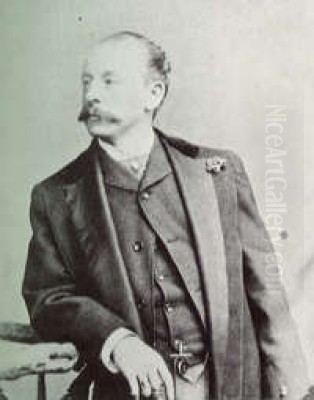
Alfred Thompson Bricher stands as a significant figure in nineteenth-century American art, celebrated primarily for his evocative and meticulously rendered marine landscapes. Active during a period of profound change and development in American painting, Bricher carved a distinct niche for himself, capturing the sublime beauty and tranquil power of the New England coastline. Associated with the later phases of the Hudson River School and a key proponent of Luminism, his work offers a unique window into the nation's engagement with its natural environment during the latter half of the 1800s. His paintings, characterized by their crystalline light, serene atmosphere, and detailed observation, continue to resonate with viewers today.
Early Life and Artistic Awakening
Born in Portsmouth, New Hampshire, in 1837, Alfred Thompson Bricher's early life set the stage for his later artistic pursuits. His family relocated to Newburyport, Massachusetts, a coastal town that likely instilled in him an early appreciation for the maritime environment. Formal education included attendance at the academy in Newburyport. However, his initial career path led him not to art, but to the world of commerce in Boston. During the 1850s, while engaged in business, the pull towards art proved irresistible.
Bricher was largely self-taught as a painter, a common path for many American artists of his generation. He supplemented his independent study by taking classes at the Lowell Institute in Boston. This period was crucial for his development, exposing him to the burgeoning Boston art scene and potentially to the works and teachings of influential figures. Artists like William Morris Hunt, who brought the influence of the French Barbizon school back to New England, and the already renowned landscape painter Albert Bierstadt, known for his dramatic Western scenes but also active in the East, were prominent in the region and may have provided indirect inspiration or early guidance during Bricher's formative years.
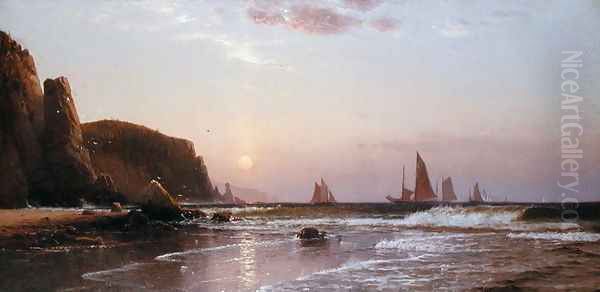
By 1858, Bricher made the decisive leap to pursue art full-time, initially establishing a studio in Boston before moving to his old haunt of Newburyport. His early works focused primarily on landscape subjects, often depicting the autumnal scenery of New England, reflecting the prevailing tastes influenced by the Hudson River School aesthetic. This initial phase demonstrated his burgeoning technical skill and his keen eye for natural detail, laying the groundwork for his later specialization.
A Turn Towards the Sea
The late 1860s and early 1870s marked a pivotal shift in Bricher's artistic focus. While he continued to paint landscapes, his attention turned increasingly towards the coast and the sea. In 1868, he moved to New York City, a move that placed him at the center of the American art world and facilitated greater exposure and professional connections. It was around this time that his dedication to marine subjects solidified, becoming the defining characteristic of his oeuvre for the remainder of his long career.
His commitment to capturing the coast was not merely a studio practice. Bricher became an inveterate traveler and sketcher, spending his summers exploring the shorelines of Massachusetts, Maine (including Mount Desert Island and its surroundings), Rhode Island, Long Island, and even venturing further afield to Grand Manan Island in the Bay of Fundy, Canada. These sketching expeditions were fundamental to his process. He would meticulously record observations of light, water, rock formations, and atmospheric conditions in pencil and watercolor sketches, which then served as the basis for larger, more finished oil paintings completed in his studio.
This period saw him develop relationships and share affinities with other artists drawn to similar subjects. His friendship with William Stanley Haseltine, another painter renowned for his precise and geologically accurate depictions of the rocky New England coast, was particularly significant. Haseltine's detailed approach likely reinforced Bricher's own inclination towards careful rendering. Furthermore, Bricher's work from the 1860s onwards shows a strong connection to Martin Johnson Heade, particularly in their shared exploration of coastal marshes and the effects of light, placing both artists firmly within the Luminist sensibility.
The Luminist Vision
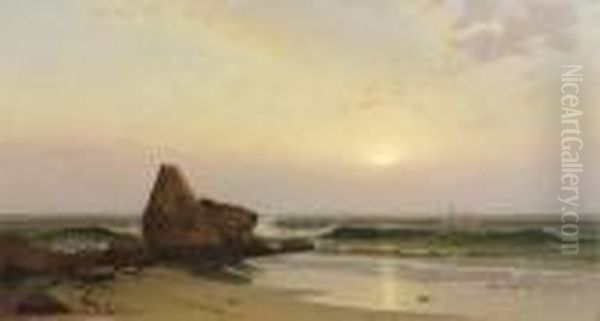
Alfred Thompson Bricher is considered one of the foremost painters associated with Luminism, a distinct movement or style within nineteenth-century American landscape painting. Flourishing roughly between the 1850s and 1870s, Luminism is characterized by its emphasis on light and atmosphere, often rendered with smooth, invisible brushwork to create a sense of stillness, clarity, and profound tranquility. Luminist painters sought to capture the subtle effects of light on water and sky, frequently depicting scenes at dawn or dusk, or under the calm, hazy conditions of a summer day.
Bricher's work embodies many key characteristics of Luminism. His paintings often feature expansive, horizontal compositions, emphasizing the vastness of the sea and sky. He excelled at depicting the reflective qualities of calm water, capturing the subtle interplay of light and color on its surface. His skies are typically serene, filled with a cool, clear light, often rendered in delicate gradations of tone. The overall effect is one of quiet contemplation and harmony, inviting the viewer to experience the peaceful solitude of the coastal landscape.
Unlike some of the earlier Hudson River School painters such as Thomas Cole or Asher B. Durand, whose works often carried overt moral or narrative messages, Bricher's Luminist paintings are generally more focused on the purely aesthetic and experiential aspects of nature. While sharing a reverence for the American landscape with his predecessors, his approach, like that of fellow Luminists Fitz Henry Lane and John Frederick Kensett, emphasized mood and atmosphere achieved through the meticulous control of light and tone, rather than dramatic compositions or allegorical content. His brushwork is typically tight and controlled, minimizing the artist's visible hand to enhance the illusion of reality and the sense of quietude.
Signature Style and Techniques
Bricher developed a highly recognizable style marked by technical proficiency and a consistent aesthetic vision. His draftsmanship was precise, evident in the careful delineation of rock formations, waves, and distant shorelines. He possessed a remarkable ability to render the textures of different natural elements – the solidity of granite cliffs, the wetness of sand, the transparency of shallow water, and the frothy energy of breaking waves. This attention to detail grounds his often idealized scenes in a convincing naturalism.
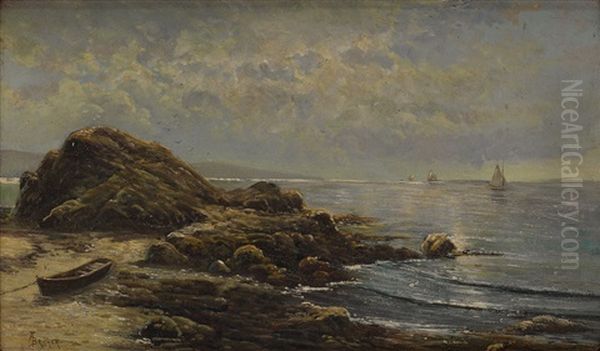
His handling of light was perhaps his greatest strength. He masterfully captured the cool, silvery light of the North Atlantic coast, often depicting the subtle shifts in illumination that occur throughout the day. Whether portraying the crisp clarity of morning, the hazy glow of midday, or the soft radiance of twilight, Bricher's sensitivity to light effects imbued his paintings with a palpable sense of time and place. His palette often favored cool blues, greens, and grays, accented with touches of warmer yellows, pinks, or oranges, particularly in his sunrise or sunset scenes, creating harmonious and atmospheric color schemes.
While renowned for his tranquil scenes, Bricher was also adept at capturing the dynamic movement of water. He developed specific formulas for depicting waves – from gentle swells lapping the shore to more dramatic breakers crashing against rocks. These waves are often rendered with a characteristic pattern of light and shadow that conveys both their energy and their liquid form. Figures are typically absent or small in scale, emphasizing the dominance of nature and enhancing the sense of solitude and timelessness that pervades much of his work. He worked proficiently in both oil and watercolor, bringing a similar level of detail and atmospheric sensitivity to both mediums.
Key Works and Recurring Themes
Among Bricher's most celebrated works is Morning at Grand Manan, painted in 1878. This large canvas, now housed in the Indianapolis Museum of Art, exemplifies his mature style. It depicts the rugged coastline of Grand Manan Island under the soft light of early morning. The composition features a dramatic interplay of rocky cliffs, calm reflective water in the foreground, and gentle waves breaking further out. The painting showcases Bricher's mastery of light, his meticulous rendering of geological detail, and his ability to create a scene of profound peace and majestic beauty. It is often considered a pinnacle of his achievement within the Luminist mode.
Other notable works further illustrate the range and consistency of his vision. Coastline near Otter Cliffs captures the distinctive pink granite cliffs of Mount Desert Island, Maine, demonstrating his skill in rendering specific geological features under particular light conditions. The Canal at Portland, Maine offers a view that includes elements of human activity within the coastal landscape, though nature remains the dominant focus. Paintings like Morning at Narragansett continue his exploration of serene coastal mornings, often featuring calm seas, distant sailboats, and meticulously rendered shorelines, showcasing his characteristic cool palette and tranquil atmosphere.
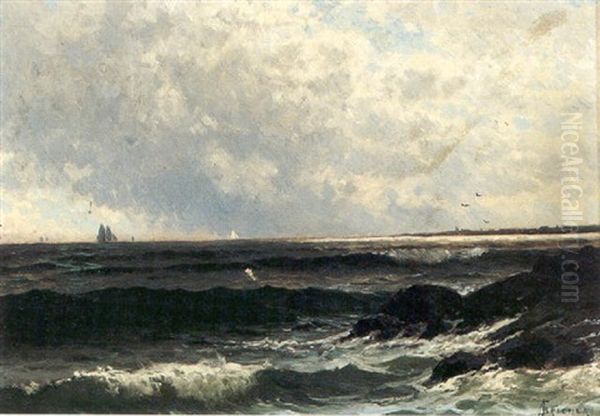
Recurring themes in Bricher's work include the meeting of land and sea, the play of light on water, and the enduring presence of coastal rock formations. He frequently returned to favorite locations along the New England coast, exploring different times of day and weather conditions. While tranquility dominates, some works depict slightly more active seas, though rarely the violent storms favored by some earlier marine painters. His focus remained largely on the picturesque and sublime aspects of the coast, presented with clarity and poetic sensibility.
Professional Recognition and Exhibitions
Throughout his career, Bricher achieved considerable professional recognition, exhibiting his work regularly and participating actively in the art community. His move to New York in 1868 facilitated his integration into major art institutions. He became an associate member of the prestigious National Academy of Design (NAD) in 1879, frequently exhibiting his paintings in their annual exhibitions. He was also an early and active member of the American Society of Painters in Water Colors (later the American Watercolor Society, AWS), serving on its board and exhibiting watercolors regularly, demonstrating his commitment to that medium.
Bricher's work reached a wide audience through major national and international exhibitions. He exhibited at the landmark Philadelphia Centennial Exposition of 1876, a crucial event for showcasing American art and industry to the world. He also participated in the World's Columbian Exposition held in Chicago in 1893, further cementing his national reputation. Beyond these large fairs, his paintings were shown at venues such as the Boston Art Club and the Brooklyn Art Association, ensuring visibility among collectors and critics.
His popularity was also significantly boosted through his collaboration with Louis Prang & Company, a leading publisher of chromolithographs. Prang reproduced several of Bricher's paintings as high-quality prints, making his coastal scenes accessible to a broader middle-class audience who could not afford original oils or watercolors. This dissemination of his imagery contributed greatly to his fame during his lifetime, making his particular vision of the American coastline familiar across the country. The 1973 retrospective exhibition organized by the Indianapolis Museum of Art, accompanied by a catalogue raisonné by Jeffrey R. Brown, marked a crucial moment in the modern reassessment of his career.
Influences and Artistic Circle
Bricher's art developed within the rich context of nineteenth-century American landscape painting. He clearly inherited the legacy of the Hudson River School, particularly its emphasis on detailed realism and the celebration of American nature. While perhaps less overtly spiritual or nationalistic than early figures like Thomas Cole or Asher B. Durand, Bricher shared their commitment to careful observation and skilled execution. He can be seen as extending the tradition established by the first generation and refined by later figures like Frederic Edwin Church and John Frederick Kensett, adapting it to his preferred coastal subjects and Luminist sensibility.
His connection to the White Mountain School of painting is also notable. Like artists such as Benjamin Champney and Samuel Colman, Bricher spent time sketching in the White Mountains of New Hampshire, particularly earlier in his career. While he ultimately became known for his coastal scenes, his time in the mountains likely honed his skills in depicting landscape forms and atmospheric effects, contributing to the overall development of his style. The shared practice of summer sketching trips fostered a sense of community and exchange among these artists.
Beyond these broader movements, specific artists clearly impacted his work. As mentioned, William Stanley Haseltine's geological precision and Martin Johnson Heade's atmospheric coastal scenes were significant influences or parallels. The Barbizon-influenced tonalism promoted by William Morris Hunt in Boston may have contributed to Bricher's sensitivity to light and mood, even as Bricher maintained a higher degree of realism. He also worked alongside other prominent marine painters of the era, such as William Trost Richards, who similarly specialized in detailed coastal views, though often with a different emphasis or mood. Bricher navigated these various influences to forge his own distinctive and enduring style.
Later Career and Rediscovery
Alfred Thompson Bricher continued to paint prolifically throughout the late nineteenth and early twentieth centuries, maintaining his studio in the Staten Island area of New York City after the 1890s. He remained dedicated to his signature coastal subjects, producing countless variations on his favorite themes along the shores of New England and Long Island. While his style remained largely consistent, grounded in the realist and Luminist principles he had mastered decades earlier, the art world around him was changing rapidly.
The rise of Impressionism, Tonalism, and various strands of Modernism in the late nineteenth and early twentieth centuries led to a shift in aesthetic tastes. Bricher's detailed, meticulously finished style began to seem old-fashioned to progressive critics and collectors. While he maintained a degree of popularity, particularly through the continued circulation of Prang's chromolithographs, his critical standing diminished, and like many artists of his generation associated with the Hudson River School tradition, he fell into relative obscurity following his death in 1908.
However, the mid-to-late twentieth century witnessed a major revival of interest in nineteenth-century American art, including the Hudson River School and Luminism. Scholars and curators began to re-evaluate artists who had been overlooked. Bricher's work, with its technical brilliance, evocative beauty, and consistent vision, was ripe for rediscovery. Exhibitions, publications (like the 1973 catalogue raisonné), and a growing appreciation for Luminism brought his paintings back into the spotlight. By the 1980s, Alfred Thompson Bricher was once again recognized as one of the most important and accomplished American marine painters of his era.
Critical Reception and Enduring Importance
Contemporary critical reception of Bricher's work during his lifetime was generally positive, acknowledging his technical skill and the appealing nature of his subjects. He was praised for his delicate handling of light and atmosphere, and his ability to capture the specific character of the New England coast. However, some critics occasionally found his work repetitive or overly reliant on established formulas, particularly later in his career when he produced numerous similar coastal views. The sheer volume of his output sometimes led to suggestions of commercialism, although his dedication to his craft was rarely questioned.
Today, Alfred Thompson Bricher is highly regarded by art historians and collectors. He is celebrated as a leading exponent of American Luminism and one of the nineteenth century's most skilled marine painters. His work is admired for its technical finesse, its serene beauty, and its consistent exploration of light and atmosphere along the American coastline. While acknowledging the formulaic tendencies in some of his later work, scholars emphasize his significant contribution to American landscape painting and his mastery in capturing the unique qualities of the maritime environment.
His paintings are now held in the permanent collections of major American museums, including the Metropolitan Museum of Art in New York, the Smithsonian American Art Museum in Washington D.C., the Museum of Fine Arts, Boston, the Carnegie Museum of Art in Pittsburgh, the Brooklyn Museum, and the Indianapolis Museum of Art, among many others. The enduring appeal of his work lies in its ability to transport the viewer to the tranquil shores of nineteenth-century New England, offering moments of quiet contemplation and appreciation for the subtle beauties of the natural world, rendered with exceptional clarity and grace.
Conclusion
Alfred Thompson Bricher's legacy is secured by his beautiful and evocative depictions of the American coast. From his self-directed beginnings to his rise as a prominent member of the New York art world and a key figure in Luminism, he remained steadfastly dedicated to capturing the interplay of light, water, and land. His meticulous technique, sensitivity to atmosphere, and consistent focus on the serene aspects of the marine environment resulted in a body of work that defined a particular vision of the New England shoreline. Though temporarily eclipsed by changing artistic fashions, his rediscovery has rightfully placed him among the masters of nineteenth-century American landscape painting, his tranquil seascapes continuing to captivate audiences with their timeless beauty and quiet power.